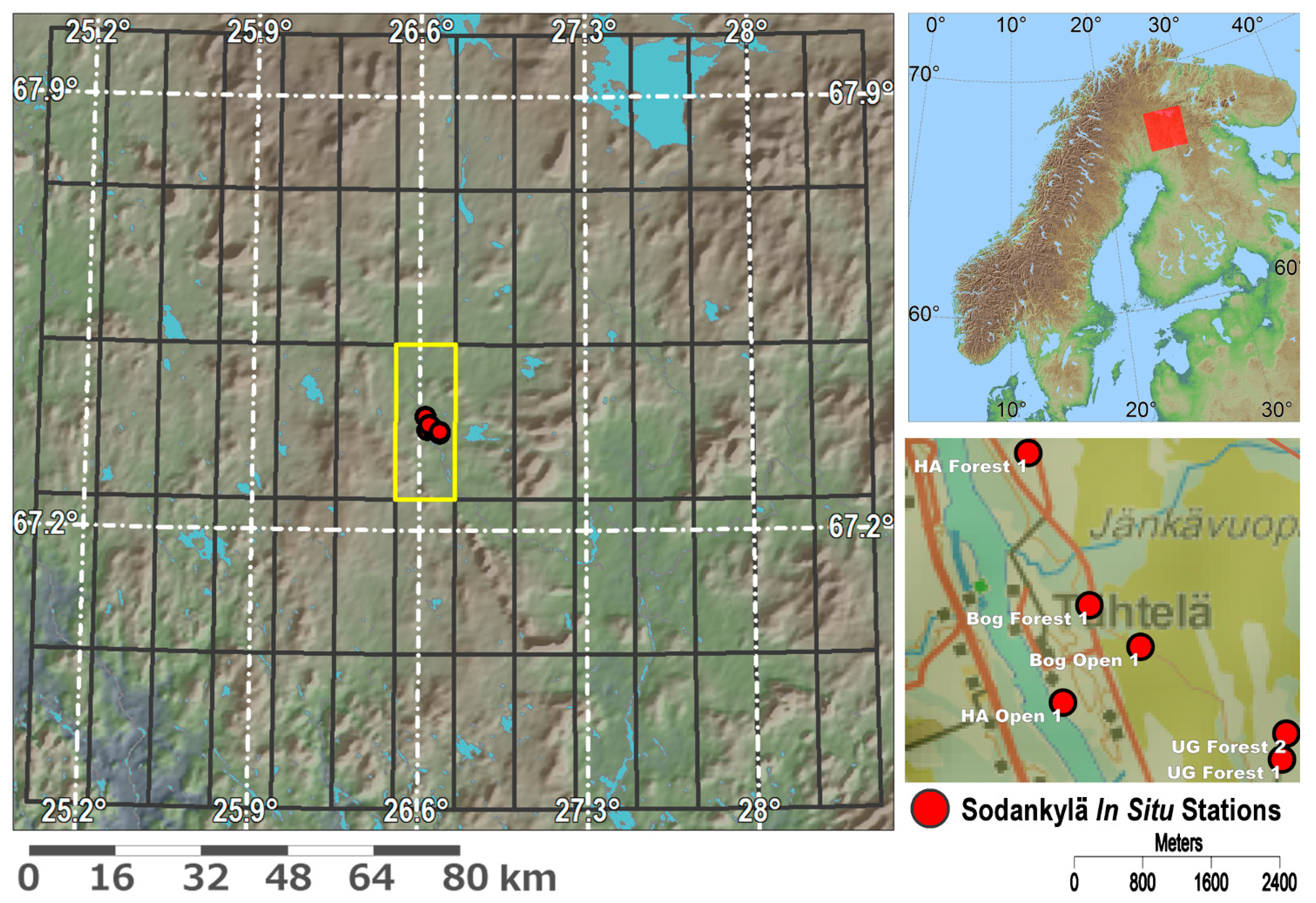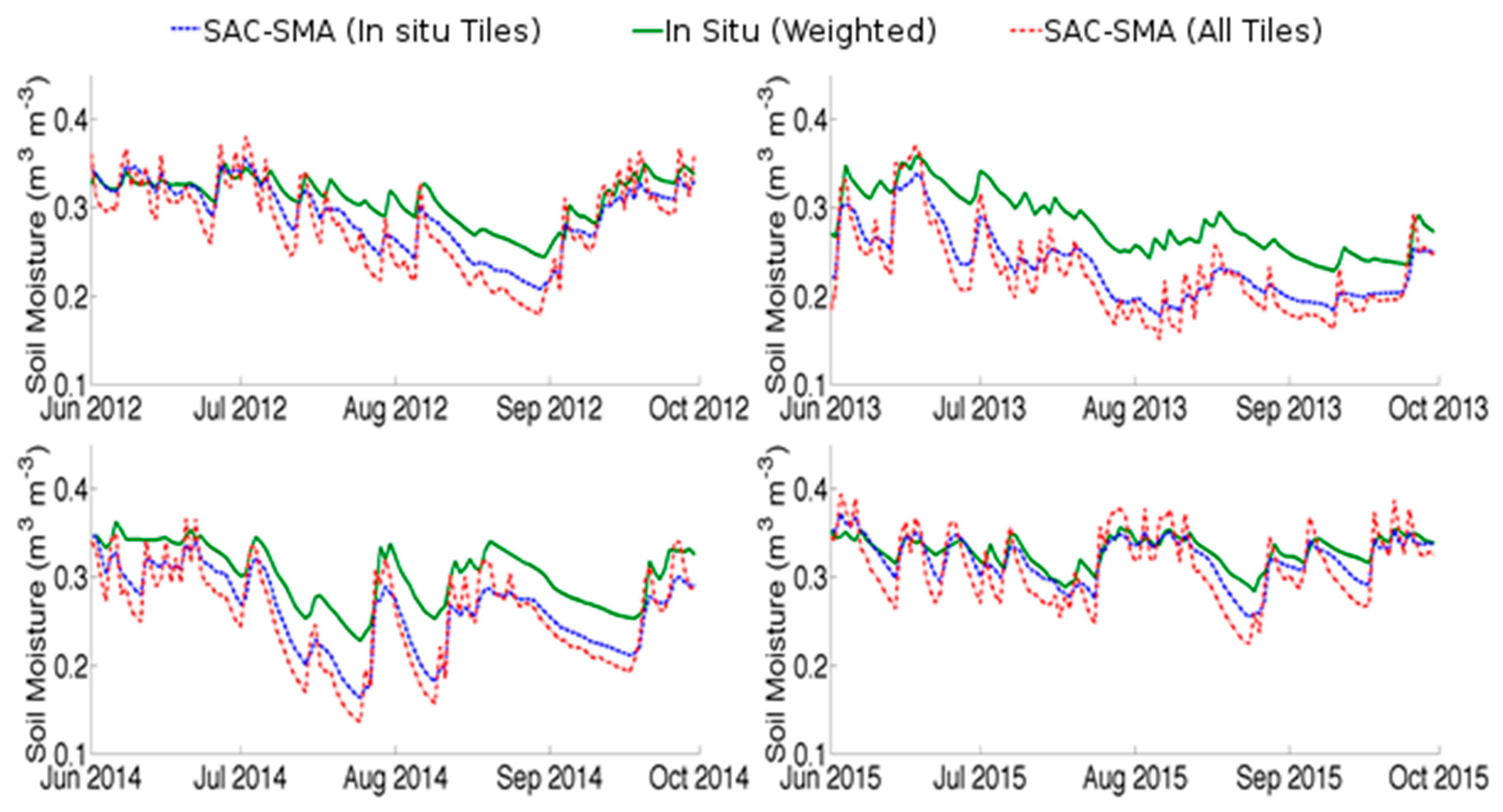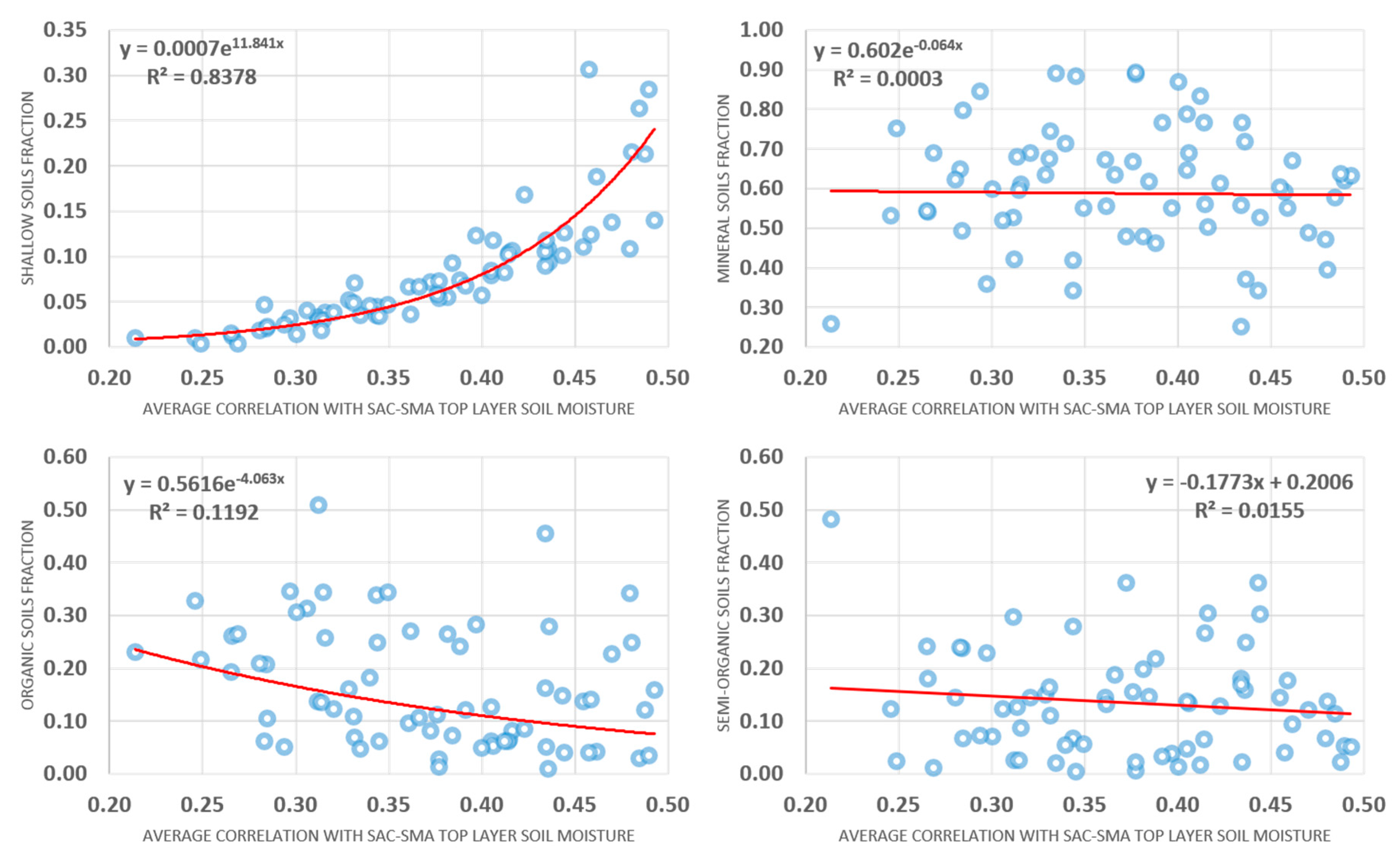We conduct a spatially distributed evaluation of the ESA CCI SM COMBINED product and its components; ACTIVE and PASSIVE soil moisture retrievals for thawed/snow-free periods between 2003 and 2015 using SAC-SMA model top-layer soil moisture as the reference dataset. The 70-pixel aggregate yearly average correlation between the ESA CCI SM COMBINED product and SAC-SMA model top layer soil moisture estimates varies significantly; from 0.035 to 0.512. The highest 70-pixel aggregate yearly correlation is reached during 2011 and the lowest correlation is observed for 2007 (see
Figure 4). The average 15 year 70-pixel aggregate correlation with SAC-SMA model soil moisture estimates for the ESA CCI SM COMBINED product is relatively low at 0.34. The 70-pixel aggregate correlation of the ACTIVE product ranges from 0.07 to 0.67, with an average of 0.37. The highest correlation is achieved in 2012, while the lowest correlation is reached in 2004 (see
Figure 5). The PASSIVE product soil moisture correlation with SAC-SMA model top layer soil moisture estimates ranges from −0.27 to 0.43, with an average of only 0.22 (see
Figure 6). As with the ESA CCI SM COMBINED product, the lowest 70-pixel aggregate correlation for the PASSIVE products is reached in 2007. The highest aggregate yearly correlation, as with the ACTIVE product, is achieved in 2012.
There exists a considerable amount of variation in terms of the correlation between the pixels and high 15-year average standard deviation in some pixels for all ESA CCI SM products. With the ESA CCI SM COMBINED product, the average standard deviation is 0.34, while for the ACTIVE product it is 0.37 and for the PASSIVE product it is 0.22. Particularly noteworthy is the fact that pixels with a low average annual correlation with SAC-SMA model top soil layer estimates, often have a higher standard deviation of correlation between the analysis years. A noticeable positive trend towards improved performance for latter years for all of the ESA CCI SM products can be observed. However, with the ACTIVE product, this trend is far clearer (see
Figure 4,
Figure 5 and
Figure 6). Although the highest and lowest correlation years for the ACTIVE and PASSIVE products do not match, both the ACTIVE and PASSIVE products exhibit poor performance during 2004, 2007, and 2014. There exists no distinguishable common meteorological factors or anomalies between the years that can explain this finding, rendering it challenging to assess the reasons for poor performance, at least in terms of a single explanatory factor affecting both soil moisture retrieval methods. From
Figure 4,
Figure 5 and
Figure 6, it can also be observed that there is no clearly discernible geographical trend in correlation with SAC-SMA model top layer soil moisture estimates for any of the ESA CCI SM products.
Spatio-Statistical Pattern Analysis
We explore the dependency of PASSIVE and ACTIVE soil moisture retrieval performance to differences in soil/vegetation type tile coverage within each SAC-SMA model grid cell (i.e., ESA CCI SM product pixel). This is explored in order to determine if any specific soil/vegetation combination(s) are a factor in determining ESA CCI SM product correlation with SAC-SMA model soil moisture, i.e., does the domination of some soil/vegetation type combination within a pixel increase or decrease ESA CCI SM data product performance. With this assessment, for simplicity and since mineral soil/vegetation tile soil moisture correlate strongly with each other, all mineral soil/vegetation tiles (excluding shallow soils) are merged into a single “mineral soils” tile. In
Figure 7, we provide diagrams of major soil/vegetation type fraction sizes against ACTIVE soil moisture retrieval correlation with SAC-SMA model top layer soil moisture estimates. A best fit trend line along with the equation describing the relationship and the R-squared value is also provided. From
Figure 7, we can deduce that there exists a significant exponential relationship (R-squared value of 0.8378) between ACTIVE soil moisture retrieval correlations with SAC-SMA model top layer soil moisture estimates and the size of the shallow soils fraction in a pixel. The relationship is given as:
where,
y is the correlation of ACTIVE soil moisture retrieval with SAC-SMA model top layer soil moisture and
x is the size of shallow soils fraction within a pixel. The other major soil/vegetation type fractions do not exhibit significant relationships with ACTIVE soil moisture retrieval and SAC-SMA model top layer soil moisture estimate correlations. Further, it is not possible to define a statistically significant multiple linear regression model describing the dependency of major soil type fractions and ACTIVE soil moisture retrieval correlation with SAC-SMA model top layer soil moisture estimates. As such, the exponential relationship between shallow soil fraction size and correlation with SAC-SMA model estimates is the single best predictor.
In
Figure 8, we provide corresponding diagrams of major soil/vegetation type fraction sizes against PASSIVE soil moisture retrieval correlation with SAC-SMA model top layer soil moisture estimates. As with ACTIVE soil moisture retrieval analysis, a best fit trend line along with the equation describing the relationship and with the R-squared value is also provided. For PASSIVE soil moisture retrievals, multiple relationships exist between major soil type fraction size and correlation with SAC-SMA model top layer soil moisture. In contrast to the ACTIVE soil moisture retrieval relationship with shallow soil fraction size, PASSIVE soil moisture retrievals exhibit a negative exponential trend (with an R-squared value of 0.4808) in correlation. The relationship is given as:
where,
y is the correlation of PASSIVE soil moisture retrieval with SAC-SMA model top layer soil moisture and
x is the size of shallow soils fraction within a pixel. The size of organic soil fraction size also exhibits a somewhat significant relationship with PASSIVE soil moisture retrieval correlation with SAC-SMA model top layer soil moisture. In contrast to shallow soil fraction size, this relationship can be expressed with a positive exponential trend (with an R-squared value of 0.3614). The relationship is given as:
where,
y is the correlation of PASSIVE soil moisture retrieval with SAC-SMA model top layer soil moisture and
x is the size of organic soils fraction within a pixel. Dependencies also exist between the other (mineral soil and semi-organic soil) major soil/vegetation type fractions size and PASSIVE soil moisture retrieval correlation with SAC-SMA top layer soil moisture, but these relationships alone are rather weak (see
Figure 8).
Since multiple soil/vegetation type fraction size relationships exist between PASSIVE soil moisture retrieval correlation with SAC-SMA model top layer soil moisture, we perform exploratory statistical analysis to combine the individual relationships together with two multiple linear regression models that predict PASSIVE soil moisture correlation with the SAC-SMA model estimates. The two multiple linear regression models are described in
Table 6,
Table 7 and
Table 8. The first model, in practice, describes the same relationship as is evident with individual soil/vegetation fraction size and PASSIVE soil moisture retrieval correlation with SAC-SMA model estimates, except with a higher R-squared value (0.5878). With PASSIVE soil moisture retrievals, the higher the organic soil fraction size and the lower the shallow soil fraction size, the higher the correlation with SAC-SMA model top layer soil moisture estimates are. The model is given as:
where,
y is the correlation of PASSIVE soil moisture retrieval with SAC-SMA model top layer soil moisture,
X1 is the size of shallow soils fraction within a pixel, and
X2 is the size of organic soils fraction within a pixel. The second multiple linear regression model excludes the shallow soils fraction and predicts PASSIVE soil moisture retrieval with SAC-SMA model top layer soil moisture as a function of mineral, semi-organic, and organic soil tile fraction sizes. Although the model provides a slightly higher R-squared value (0.6114), the negative intercept value renders the model somewhat less meaningful, since a positive correlation is only achieved when approximately half of a pixel’s total area consists of some other major soil type other than shallow soils. In practice, however, pixels with more than half the total area covered by shallow soils alone are rare and in-fact non-existent in the Sodankylä study domain, therefore rendering the model valid, albeit conceptually slightly less significant. The model is given as:
where,
y is the correlation of PASSIVE soil moisture retrieval with SAC-SMA model top layer soil moisture,
X1 is the size of mineral soils fraction within a pixel,
X2 is the size of semi-organic soils fraction within a pixel, and
X3 is the size of organic soils fraction within a pixel.
In addition to PASSIVE and ACTIVE soil moisture retrieval performance dependency on major soil/vegetation type tile fraction sizes, we also examine soil moisture inter-pixel cross-correlation for both products. We examine the degree to which soil moisture time series correlate between all pixels in the study domain, and whether there is any distance-based decay in such associations. Inter-pixel soil moisture cross-correlation is assessed by correlating each pixel’s soil moisture time series with all other pixels in the study domain on a yearly basis (between the years 2003 and 2015). This results in a “pixel-pair” vector with 2485 cross-correlated members for each year and for both products. The distance between each pixel pairs’ centre point is used to create a distance vector which is correlated with the pixel-pair cross-correlation vector as a measure of distance dependent correlation decay. By definition, the relationship (correlation) between the pixel-pair and distance vectors is negative, since pixel-pairs further away from one another tend to exhibit lower correlation-coefficients than pixel-pairs that are closer to one another.
As part of the spatial association assessment, we also calculate the study domain wide average inter-pixel cross-correlation for each year as a measure of general soil moisture time series similarity between the pixels. The higher the domain wide average inter-pixel cross-correlation, and the higher the negative correlation between pixel-pair and distance vectors, the less variability there is between the pixels’ soil moisture time series and the more of this variation can be explained solely by the distances between pixels. Conversely, the lower the domain wide average pixel-pair correlation, the more soil moisture time series variability there is between the pixels. Further, the lower the negative correlation between the pixel-pair and distance vectors, the more other factors in conjunction with distance determine inter-pixel cross-correlations. The yearly average inter-pixel soil moisture cross-correlation, as well as distance dependent correlation decay values, are provided in
Table 9. The relationship between individual pixel-pair vector member correlations and corresponding distance vector members is illustrated in
Figure 9. As a reference, we also compute the same spatial association metrics for FMI interpolated daily 10 km resolution precipitation observations, as well as SAC-SMA model top layer soil moisture estimates.
Both the ACTIVE soil moisture product and FMI interpolated daily 10 km resolution precipitation observations exhibit high yearly average inter-pixel cross-correlations and high negative yearly inter-pixel cross-correlation with distance. This appears to indicate that nearby pixels’ soil moistures tend to correlate with each other irrespective of the physiographic differences between them. Low spatial variability for precipitation in northern latitudes, such as in the Sodankylä region, is expected since the majority of precipitation events are known to be caused by precipitation fronts rather than by convective storm cells. However, this should not necessarily be the case for soil moisture, which is affected by not only meteorological conditions, but also by physiographic characteristics as well, which in the Sodankylä region exhibit considerable variation from ESA CCI SM pixel to pixel. This, and the very high dependency of these correlations to shallow soils fractions, as well as the known rapid response of these soil types to both precipitation and evaporation, raises the question that the relatively good performance of the ACTIVE product with SAC-SMA model top soil estimates may be good “for the wrong reasons”. We therefore argue that it is possible that ACTIVE soil moisture retrievals likely respond mainly to direct changes in precipitation and possibly to moisture on vegetation surfaces rather than to actual moisture in the top soil layer. Although the correlation between PASSIVE soil moisture retrievals and SAC-SMA model top layer soil moisture is rather low, they both exhibit a similar, low negative correlation between pixel-pairs and distance. This, and the fact that the PASSIVE product appears to be responding to differences in soil type distributions between pixels, points to the greater ability of the PASSIVE product to represent changes in soil moisture over the ACTIVE product in the Sodankylä region.













